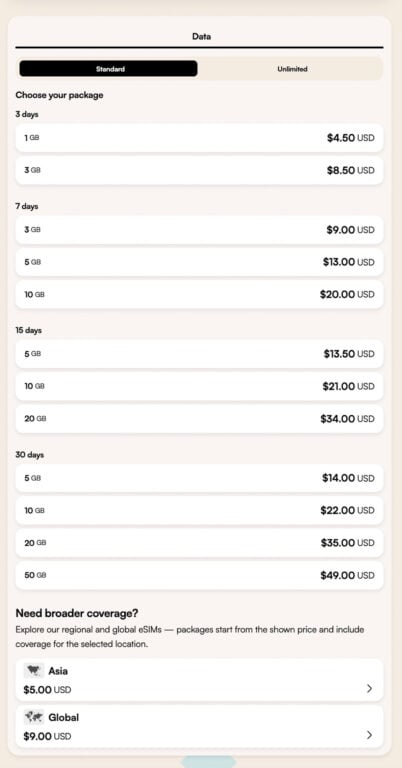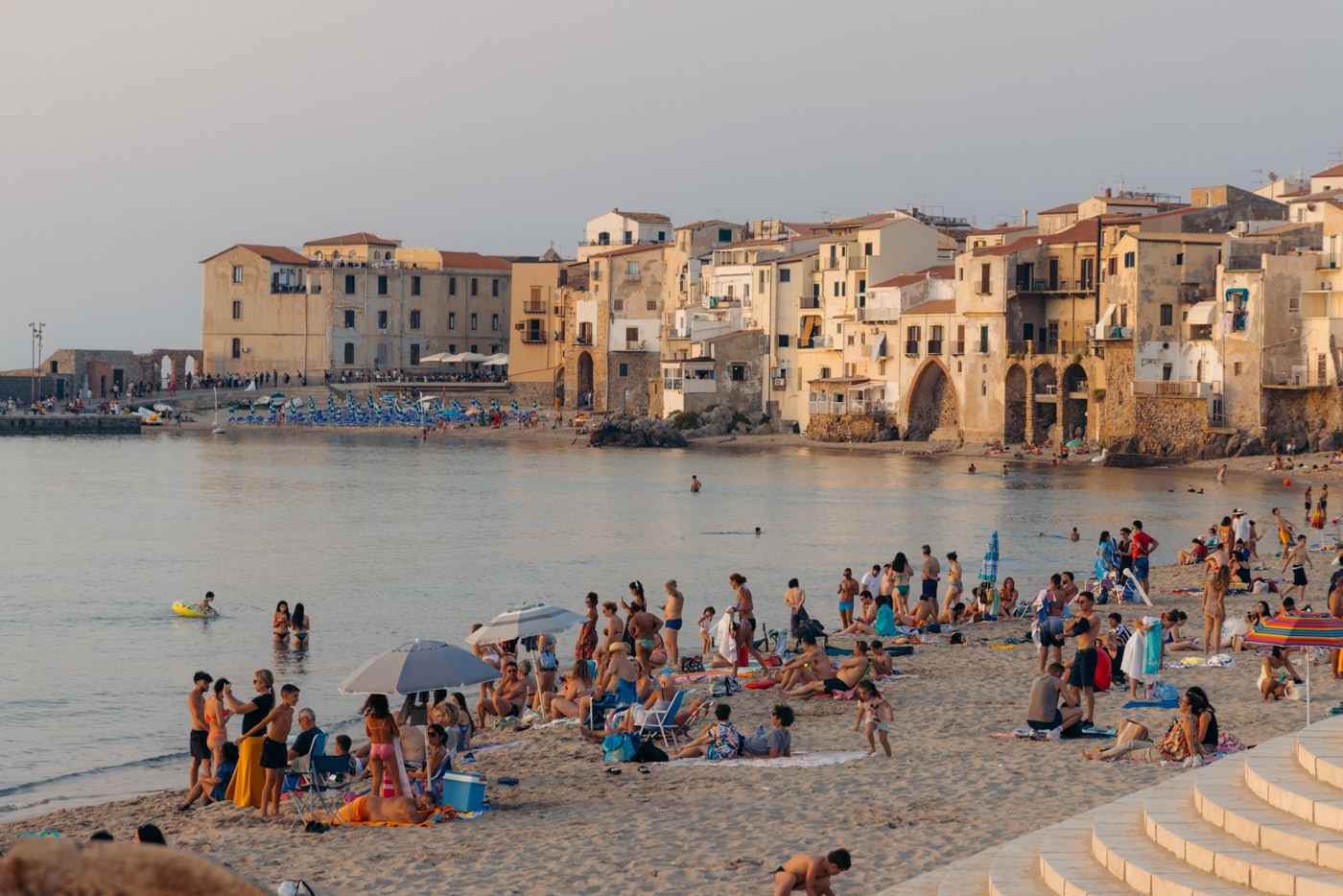When I first started traveling full-time back in 2018, buying a local SIM card was one of the first things I did in every new country, usually from an airport kiosk or the Alfamart or 7/Eleven closest to my hostel.
Fast forward seven years, and getting a SIM card is still one of my first logistical steps when I arrive in a new country. However, now I can tick this one off while waiting for the airplane seatbelt light to switch off.
eSIMs have gone from being expensive and niche to becoming one of the most practical tools for international travelers. I used to avoid them since they were more expensive than local SIMs. But, with more competition, prices have dropped, data speeds have improved, and plan options now range from regional bundles to unlimited global coverage.
In this guide, I’ll provide a fair and unbiased comparison of Holafly vs Airalo—two of the best travel eSIMs available at the moment. I’ve personally used and recommended both of these across destinations in Southeast Asia, Europe, and beyond and below I’ll explain which I continue to use where, and why.
Quick Take: Which eSIM Should Most Travelers Pick?
Wait Before You Buy! How eSIMs Work
First things first: an eSIM is a digital SIM card in your phone. Instead of inserting a physical SIM, you scan a QR code or download an app to activate your plan, you don't need anything physical, besides your phone.
That’s it, no swapping SIMs at the airport, no hunting for local stores.
Sounds simple, right? It is as long as your phone supports it. This is the single most important step. Holafly has a phone compatibility tool on its website and app. Use this before buying anything. Almost all eSIM companies make refunds impossible if your phone isn’t compatible.
In fact, nearly all the negative reviews I’ve read, for both Holafly and Airalo, come from travelers who tried to use an eSIM on an unsupported device and were unable to get a refund since these kinds of companies have very limited customer service (still better than a standard telcom provider).
So check first, save yourself a headache, and only then move on to picking your plan!

Holafly vs Airalo: Quick Comparison
| Feature | Airalo | Holafly |
|---|---|---|
| Countries Covered | 200+ | 200+ |
| Plan Types | Fixed data (1GB to 20GB+) | Unlimited data with daily, monthly, or custom durations. |
| Pricing | Per GB, different per country. | $29.90 for unlimited data |
| Hotspot | Yes | Yes (limited to 500MB-2GB/day depending on plan) |
| Throttling/Speed | No throttling | Throttles after 3-5GB/day high-speed |
| Activation Process | QR scan or app install | QR scan or app install |
| Great for: | Budget, light users (maps/email); short trips; frequent top-ups | High data users (streaming/work); longer trips; multi-country travel |
The key difference that I've noticed between Holafly and Airalo comes down to data structure and flexibility.
Holafly offers unlimited data plans for specific durations (usually 5–30 days), while Airalo sells capped data packages that range from 1 GB to 20 GB, depending on the country.
Holafly’s model is ideal for travelers who use a lot of data, for example, navigating, hotspotting, or posting travel photos. Iit's great if you want the convenience of not tracking usage.
Airalo, on the other hand, feels more like buying a local SIM directly from your phone. It’s often the cheaper option if you only need light data for maps, messaging, or occasional browsing. The trade-off is that you’ll need to monitor your usage and top up if you run out.
Overall, Holafly prioritizes simplicity and ease, while Airalo offers cost efficiency. The best choice depends on how much data you actually use while traveling. Note Airalo also offers unlimited plans in some regions but based on my comparisons they are often more expensive.
Holafly vs Airalo: Price Comparison
Before we dive into the numbers, here’s a quick reminder for anyone scrolling: the main pricing difference comes down to capped vs unlimited data. Holafly sells mostly unlimited plans for a fixed duration, while Airalo offers smaller, capped data bundles that vary by country.
On a recent trip to Indonesia, I compared both providers to see how this plays out in practice.
Airalo offers local Indonesian eSIMs starting around $4–$5 for 1–2 GB, with larger bundles of 5–20 GB going for roughly $13–$35, depending on the length of validity.

Holafly, in contrast, sells travel eSIM data plans ranging from US $6.90 for 1 day up to US $75.90 for 30 days, which is more expensive upfront but in my experience works out cheaper since you don't have to worry about topping up twice (or 3 times) if your phone decides to do an update or backup.

I was a bit surprised at how expensive both options were for Indonesia, given how cheap local SIMs can be. That made me curious to check out regions known for higher data costs, where I’ve personally used both Airalo and Holafly in the past.
In Europe, Airalo’s country-specific plans start at about $4 for 1 GB/7 days, with 5 GB/30-day plans around $15–20, and 20 GB/30-day plans roughly $39 depending on the country.
Holafly, on the other hand, offers unlimited Europe plans starting at $19.50 for 5 days, $27.30 for 7 days, and $36.90 for 10 days. In my opinion and experience using SIM cards while traveling, the Holafly plans offer more value for money, especially if you're hopping between countries like France, Germany, and Italy.
Holafly vs Airalo: Coverage & Performance
Coverage and performance really vary by country and region, it is a SIM after all, and is completely tied to local tower availability. However, if you read my note at the start on how eSIMs work, then you already know that which provider the eSIM connects to is critical, because it determines connectivity, coverage, and performance.
Again, if you’re traveling to remote places with no cell reception, you can’t expect an eSIM to work. No SIM, digital or physical, will provide coverage where towers don’t exist. So if you’re heading to remote regions like the Himalayas or Karakoram, you won’t get service no matter which eSIM you buy.
To give a fair comparison based on my experience, here’s the coverage I got while using Holafly and Airalo in Bali and Lombok.
In my experience, island-hopping around Bali and Lombok, connections remained consistently usable in tourist hubs like Denpasar and Ubud. Holafly provided strong 4G/5G coverage on Bali’s most reliable networks (Telkomsel, Indosat). Some remote spots, like when I was hiking Rinjani, didn’t have coverage at all on either eSIM, or even on my friends' local physical SIMs for that matter.
Comparing performance, I was able to get slightly faster speeds with Holafly, consistently exceeding 50 MB/s in the main tourist areas of Bali. That said, Holafly was throttled after about 3 GB of daily usage, causing slight slowdowns, but it remained very usable for maps, messaging, and browsing.

Holafly vs Airalo: Usability & Customer Support
In terms of usability, both Holafly and Airalo are extremely easy to use. You simply scan a QR code or download an app, then follow the setup process. I tested this on an iPhone 15 Pro, and it worked flawlessly, but I’ve also installed both eSIMs on an older iPhone 11 with no issues. I don’t have personal experience with Android devices, but both companies say the process is very similar.

Comparing usability, I’d say they’re essentially equal. Their apps are well-designed, but personally, I prefer not to install extra apps unless necessary. Both platforms allow you to download and install the eSIM without the app, which is a bonus. That said, if you want to track data usage, you’ll need the app, although with Holafly’s unlimited plans, that’s not necessary.
If you’ve read my Holafly review, you’ll know I had a great experience using their eSIM on a long road trip. However, that post generated many comments from users reporting that the SIM didn’t work and that getting a refund was difficult. In most cases, I noticed the complaints in the comment section came down to phone compatibility, so it’s crucial to check whether your device supports eSIMs before buying.
I haven’t personally had to contact customer support for either company, so I can’t comment firsthand on responsiveness. That said, Holafly’s main complaint seems to be that some users couldn’t get a response or a refund when the SIM didn’t work. If they want to continue building a strong brand for an excellent product, improving support and refund processes is key.
Airalo reviews show a similar pattern: users who had trouble installing the eSIM often found it difficult or impossible to get a refund. Unfortunately, this seems to be a common pain point across both platforms, which is frustrating for travelers who expect a seamless experience.

Final Verdict: Which is the Best Travel eSIM?
After testing both, Holafly is my personal favorite. For travelers like me who work online, stream, upload content, and move between countries, the simplicity of unlimited data makes life so much easier. I don’t have to monitor usage, worry about topping up mid-trip, or switch eSIMs when crossing borders.
Airalo is still very popular, but in my opinion is really best suited for short trips with light data needs. If you’re only checking messages, maps, or browsing lightly on a quick holiday, Airalo’s capped plans can and have saved me a few dollars, but only if you're really careful not to go over your data limit, or you'll end up paying twice!

